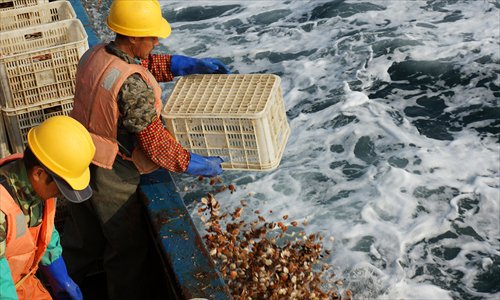Scallop producer reports massive 860m yuan loss
Claims cold water destroyed stock; investors include nation’s largest pension fund; fraud suspected by some

Workers dump boxes of infant scallops into the sea. File Photo: IC

China's largest scallop producer by output has found itself in the media spotlight for reporting over the weekend massive losses of over 800 million yuan ($130.9 million) in the third quarter because of a controversial write-off of its scallop stocks.
Dalian-based Zhangzidao Group Co, a marine producer, underlined on Saturday that a rare natural disaster - a cold water current that swept into the northern Yellow Sea from June to August - has wiped out its latest scallop stock in the sea, one of its key products, which had been reared for three years and was set to be harvested this year.
"The greater volatility of water temperature [brought by the cold water current] is the major reason for the losses," it said in a statement filed with the Shenzhen Stock Exchange where it is listed.
The statement was intended as an explanation in response to investors' doubts and inquiries after the company announced on Friday a shocking 860.8 million yuan worth of net losses attributable to its shareholders in the third quarter as a result of a write-off on falling inventory of its scallops.
The stunning development has given rise to some suspicion.
The marine producer of scallops, sea cucumbers and abalones may have used the natural disaster as a cover for financial fraud, the Beijing News reported on Sunday citing investors.
Other sea farming firms have not reported being affected by bad sea conditions in the same region.
"We are not affected," Zhao Defa, a manager at a sea farm that breeds scallops in Changhai county, Dalian, North China's Liaoning Province, told the Global Times on Sunday that there was no such cold water current.
Shandong Oriental Ocean and Shandong Homey Aquatic Development Co, two listed marine producers and rivals of Zhangzidao, also did not witness a cold water current in the Bohai Bay, the innermost gulf of the Yellow Sea, Securities Times reported on Friday, citing the board secretaries of these two firms.
The China Securities Regulatory Commission was not immediately available for comments on this firm.
There have been several cases of financial fraud in A-share history, including Central China's Hubei-based Lantian Aquaculture Development Co, Central China's Hunan-based Wanfu Biotechnology, and Southwest China's Yunnan Greenland Biological Technology Co.
Zhangzidao posted a net profit attributable to shareholders of 48.46 million yuan for the first half of this year, which is in stark contrast to the heavy losses reported over the weekend.
Shares trading of Zhangzidao has been suspended since October 14, as it said it would conduct an inventory check on the seabed of its crops, which revealed the devastating result and prompted the firm to make the massive one-time write-off.
While it remains unknown as to when the firm's stock trading will be resumed, many investors fear the share price of the company, which stood at 15.46 yuan per share on October 13, will undergo a free fall after trading restarts.
China's National Social Security Fund, the country's largest pension fund which was worth 1.24 trillion yuan by the end of 2013, is a major institutional investor in Zhangzidao.
The fund currently owns a combined portfolio of about 26 million shares in the firm, accounting for 3.82 percent of Zhangzidao's total shares.
China Life Insurance Co, the country's largest life insurer by premiums and another of Zhangzidao's institutional investors, possesses 4.45 million shares equal to a 0.63 percent stake in Zhangzidao.
"The climate change has had a great impact on fisheries and marine farming, but such a massive loss is very unusual," Ma Wenfeng, an analyst at Beijing Orient Agribusiness Consultant, told the Global Times on Sunday.
The value of aquaculture products is often higher than land crops, therefore aquaculture companies such as Zhangzidao enjoy higher growth potential and that's why social security funds invested in it, Ma said.
Extreme climate change could have been predicted, he said, noting the key is the financial credibility of the firm.